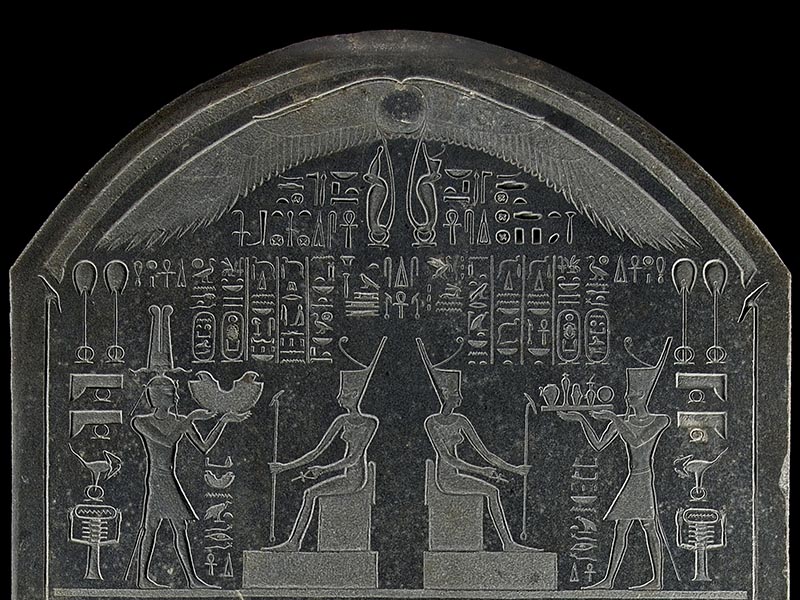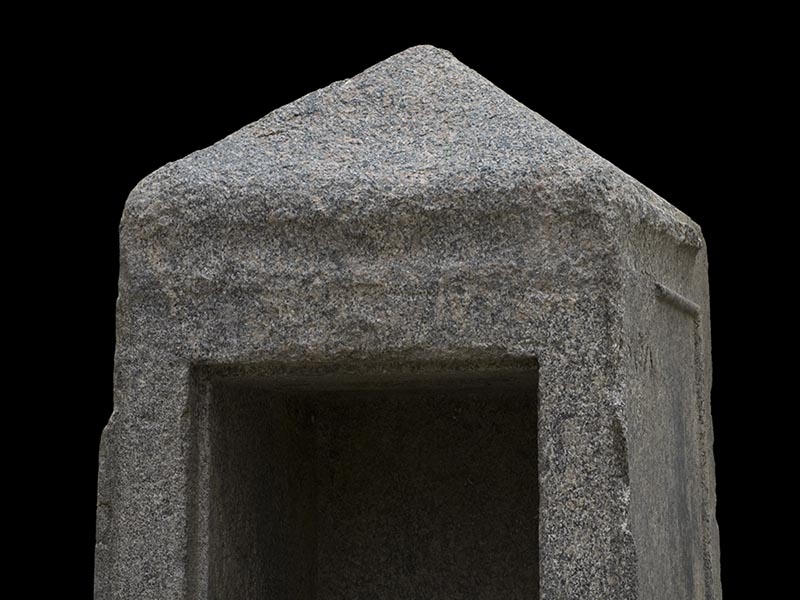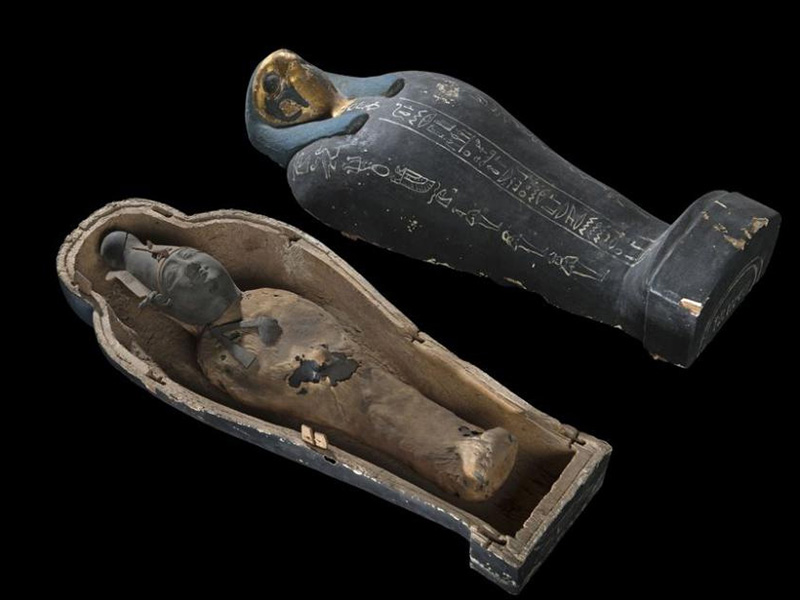Marine archaeologists examining a colossal marble head of the Greco-Egyptian god Serapis at Thonis-Herakleion, Egypt.
More than 1,200 years ago, two cities on Egypt’s north coast disappeared into the Mediterranean Sea, victims of rising tides and seismic disruption. Beginning in 1991 underwater excavations have brought a staggering array of artifacts to the surface which have fundamentally changed our understanding of the ancient Egyptian coastal region. The Sunken Cities: Egypt’s Lost Worlds audio guide features a general introduction and expert commentary on 10 works from the exhibition and 3 additional colossal sculptures.
Stop 1
Stele of Thonis-Heracleion
Thonis-Heracleion, 380 BC
 Stele of Thonis-Heracleion (detail), Thonis-Heracleion, Aboukir Bay, Egypt; Late Period, 30th Dynasty, in the reign of Nectanebo I (380-362 BC); black granodiorite; height: 74 13/16 inches; National Museum of Alexandria (SCA 277); IEASM Excavations; Photo: Christoph Gerigk © Franck Goddio / Hilti Foundation
Stele of Thonis-Heracleion (detail), Thonis-Heracleion, Aboukir Bay, Egypt; Late Period, 30th Dynasty, in the reign of Nectanebo I (380-362 BC); black granodiorite; height: 74 13/16 inches; National Museum of Alexandria (SCA 277); IEASM Excavations; Photo: Christoph Gerigk © Franck Goddio / Hilti Foundation
Stop 3
Naos of Amun-Gereb
Thonis-Heracleion, c.322-120 BC
 Naos of the temple of Amun-Gereb (detail), Thonis-Heracleion, Ptolemaic period (332-30 BC); red granite; 68 1/2 × 36 5/8 × 39 3/8 inches, weight: 6300 lb.; Maritime Museum of Alexandria (SCA 457); IEASM Excavations; Photo: Christoph Gerigk © Franck Goddio / Hilti Foundation
Naos of the temple of Amun-Gereb (detail), Thonis-Heracleion, Ptolemaic period (332-30 BC); red granite; 68 1/2 × 36 5/8 × 39 3/8 inches, weight: 6300 lb.; Maritime Museum of Alexandria (SCA 457); IEASM Excavations; Photo: Christoph Gerigk © Franck Goddio / Hilti Foundation
Stop 6
The Mysteries of Osiris
 Osiris Vegetans Figure in a Falcon-headed Coffin, c.800–600 BC; Egyptian; Third Intermediate period, 1069–664 BC; sarcophagus: sycamore wood, figurine: earth and grain; 6 5/16 × 9 13/16 × 23 5/8 inches; Egyptian Museum, Cairo (JE36539); Photo: Christoph Gerigk © Franck Goddio / Hilti Foundation
Osiris Vegetans Figure in a Falcon-headed Coffin, c.800–600 BC; Egyptian; Third Intermediate period, 1069–664 BC; sarcophagus: sycamore wood, figurine: earth and grain; 6 5/16 × 9 13/16 × 23 5/8 inches; Egyptian Museum, Cairo (JE36539); Photo: Christoph Gerigk © Franck Goddio / Hilti Foundation
Related Post
A shocking documentary proves that mermaids do exist
SHOCKING Revelation: Thuya, Mother of Queen Tiye, Was the Grandmother of Akhenaten and Tutankhamun—What Ancient Egyptian Secrets Did She Leave Behind?
Breaking News: Astonishing Discoveries at Karahan Tepe Confirm an Extraterrestrial Civilization is Hiding on Earth, and NO ONE Knows!
Breaking News: Researchers FINALLY Discover U.S. Navy Flight 19 After 75 Years Lost in the Bermuda Triangle!
NASA’s Secret Investigation: Uncovering the Astonishing Mystery of the UFO Crash on the Mountain!
Explosive UFO Docs LEAKED: Startling Proof That Aliens Ruled Ancient Egypt!
